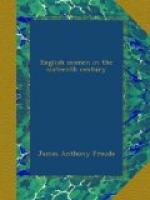Christmas was kept at St. Kitts, which was then uninhabited. A council of war was held to consider what should be done next. St. Domingo lay nearest to them. It was the finest of all the Spanish colonial cities. It was the capital of the West Indian Government, the great centre of West Indian commerce. In the cathedral, before the high altar, lay Columbus and his brother Diego. In natural wealth no island in the world outrivals Espinola, where the city stood. A vast population had collected there, far away from harm, protected, as they supposed, by the majesty of the mother country, the native inhabitants almost exterminated, themselves undreaming that any enemy could approach them from the ocean, and therefore negligent of defence and enjoying themselves in easy security.
Drake was to give them a new experience and a lesson for the future. On their way across from St. Kitts the adventurers overhauled a small vessel bound to the same port as they were. From the crew of this vessel they learnt that the harbour at St. Domingo was formed, like so many others in the West Indies, by a long sandspit, acting as a natural breakwater. The entrance was a narrow inlet at the extremity of the spit, and batteries had been mounted there to cover it. To land on the outer side of the sandbank was made impossible by the surf. There was one sheltered point only where boats could go on shore, but this was ten miles distant from the town.
Ten miles was but a morning’s march. Drake went in himself in a pinnace, surveyed the landing-place, and satisfied himself of its safety. The plan of attack at Sant Iago was to be exactly repeated. On New Year’s Eve Christopher Carlile was again landed with half the force in the fleet. Drake remained with the rest, and prepared to force the entrance of the harbour if Carlile succeeded. Their coming had been seen from the city. The alarm had been given, and the women and children, the money in the treasury, the consecrated plate, movable property of all kinds, were sent off inland as a precaution. Of regular troops there seem to have been none, but in so populous a city there was no difficulty in collecting a respectable force to defend it. The hidalgos formed a body of cavalry. The people generally were unused to arms, but they were Spaniards and brave men, and did not mean to leave their homes without a fight for it. Carlile lay still for the night. He marched at eight in the morning on New Year’s Day, advanced leisurely, and at noon found himself in front of the wall. So far he had met no resistance, but a considerable body of horse—gentlemen and their servants chiefly—charged down on him out of the bush and out of the town. He formed into a square to receive them. They came on gallantly, but were received with pike and shot, and after a few attempts gave up and retired. Two gates were in front of Carlile, with a road to each leading through a jungle. At each gate were cannon, and the jungle was lined with musketeers.




